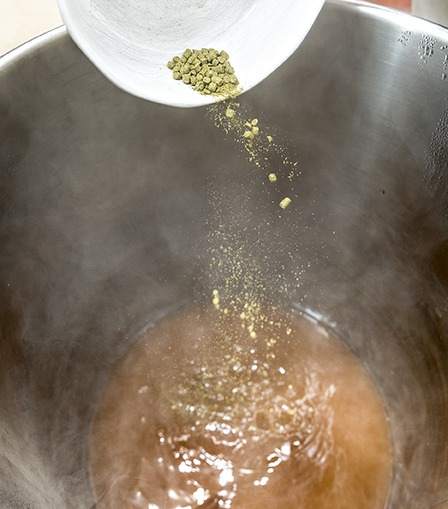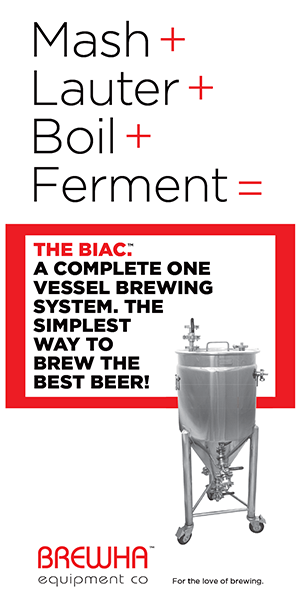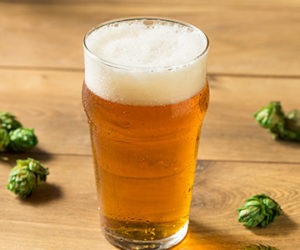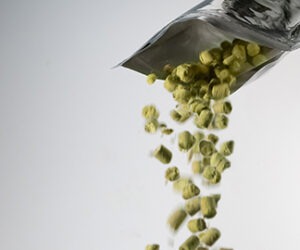Save Your Hops for Post-Boil

Some, like mash hopping, died quickly, but others like boil, flavor, and aroma hop additions have persisted. Today, I’m going to make the case that late hop additions, including “flavor” hop additions — generally boiled 30 minutes or less — are not needed, and in fact short boil additions in general are not an efficient use of hops. They don’t deliver high utilization or much in the way of aroma oils. Whirlpool and dry hopping are more effective.
Before we can discuss the merits of various hop techniques, let’s define a few terms used throughout this article:
Boil Additions – These are longer boil time additions made at the beginning of the boil, with the primary purpose being to provide bitterness and also the characteristic flavor of the hop to the finished beer.
Flavor Additions – A term that describes medium-length boil additions, generally added between 15 and 40 minutes before the end of the boil.
Finishing Additions – A boil addition added within the last 10 minutes of the boil, with the primary purpose being to add aroma to the beer.
Steeped or Whirlpool Additions – This refers to hops added at flameout, after the boil has ended, and then steeped or circulated in a whirlpool for a period of time at hot temperature before the wort is chilled.
Dry Hopping – This refers to hops added either during fermentation or after fermentation is complete.
Using the terminology above, I intend to demonstrate that both flavor and finishing additions are probably not needed, and you can more efficiently use your hops in the boil, steep/whirlpool, or dry hop phases.
A Bit of Homebrewing Hop History
When I started brewing at home in 1987, very little was known about hops, bitterness, hop aroma oils, or the best way to maximize hop flavor. We certainly knew about boil additions, late boil additions (called flavor additions) and dry hopping, but even estimating something as simple as the number of International Bitterness Units (IBUs) was not done at the homebrew level. Glenn Tinseth’s equation, which is now commonly used to do this, would not be published and widely used for another eight years!
Looking through my 1984 copy of The Complete Joy of Home Brewing by homebrewing legend Charlie Papazian, most of the recipes list the hops simply as “boiling” or “finishing” with no boil times. Boil hops were usually added for the full boil, while finishing hops were added the last 10 minutes of the boil. Also it is interesting to note that there is no distinction in the recipes between “finishing” hops added at the end of the boil and dry hops. “Finishing” hops could potentially be used in the boil or added in the fermenter.
The significantly revised New Complete Joy of Home Brewing published in 1991 adds the concept of home bitterness units (HBU), which was simply the ounces of hops multiplied by the hop’s alpha acid percentage. It was still quite inaccurate as we had no idea of the boil time, but it was a step forward. All hop additions were still simply “boil” or “finishing.”
Not until the early ‘90s do we see boil times more widely listed as well as attempts at the homebrew level to estimate the bitterness level of hop additions in IBUs. We also see a distinct breakout of bittering additions (45–90 minutes), flavoring additions (20–40 minutes) and finishing hop additions (15 minutes or less), as well as dry hopping listed in early editions of John Palmer’s classic How to Brew.
What is particularly interesting to me is his description of flavoring additions, made midway through the boil as “a compromise between isomerization of the alpha acids and evaporation of the aromatics is achieved to yield moderate bitterness and characteristic flavors.” So mid-boil flavor hops are intended to retain some aromatics while still providing bitterness.
Further, Palmer states regarding finishing hops that “fewer of the aromatic oils are lost to evaporation and more hop aroma is retained.” Finishing hops in the last 10 minutes are primarily done to preserve aromatics, and not to provide much bitterness.
As I’ll demonstrate shortly, flavoring and finishing hops actually don’t preserve aromatic hop oils very well and boiling your hops, even for a short time, will boil off a large portion of your aromatic hop oils.
Hop Flavor and Bitterness from Boiling
Hops contain well over 500 flavor compounds, and many of those compounds transform during the brewing, fermentation, and aging process in interesting ways. Relatively few of these compounds make major flavor contributions to the finished beer, though hops also act as a preservative, contribute to head retention, and perform other roles important to beer stability.
To some degree, we are only just starting to understand many of these compounds and how they transform and evolve in beer. However, a better understanding of bittering agents as well as aromatic hop oils has been a major driver in the recent rise of India pale ales with their hop-forward finish.
The best understood compounds in hops are arguably alpha acids, which have been studied for many decades. Alpha acids are a class of compounds found in the resin glands of the flower of a hop cone and provide the primary source of bitterness in hops and finished beer. These compounds include humulone, adhumulone, cohumulone, posthumulone, and prehumulone.
When alpha acids are heated in a solution they go through a process called isomerization. Isomerized alpha acids are bitter to taste, and provide the characteristic hop bitterness in beer. Boiling hops for a longer period of time leads to more isomerization, and more bittering compounds in the finished beer.
It is important to note that isomerization continues to occur at temperatures below boiling, though the rate drops quickly with temperature. At 194 °F (90 °C) you get approximately half the isomerization you would get from an equivalent boil. At 158 °F (70 °C) you will only get about 10% the utilization you get from boiling. So whirlpool hops do add some bitterness to the finished beer.
Obviously boiling hops also preserves a large number of flavor compounds characteristic to a single hop variety. For example, I’m quite sensitive to the flavor profile of Northern Brewer hops and can pretty easily identify it in a finished beer. Others may find Mosaic®, Simcoe®, and other hops easy to identify in a finished IPA. Each hop has its own boil flavor profile that you can detect even in a beer where only boil additions are made.
Aromatic Hop Oils
Most of the recent work in hops has been centered upon understanding and exploiting aromatic hop oils. Improved knowledge of these volatile but aromatic oils has been key to the recent India pale ale revolution. There are several dozen aromatic compounds that have been isolated in hops. The critical ones are called aromatic oils or essential oils and these are found in the lupulin glands on the stem of the hop cone. Aromatic oils in total only constitute 0.5% to 3% of the whole hop cone by weight.
By their nature, all of the major aromatic oils have low boiling points, which makes them volatile in air. This means they tend to disperse rapidly when exposed to air, and also are not terribly soluble in solution. The aroma you smell is in fact the volatile compounds coming out of solution, dispersing, and breaking down in the air. If these essential oils were not volatile, they would not provide much aroma. However, their volatility means that they don’t survive boiling well and many also break down when exposed to oxygen in air.
Here are the “big four” aromatic hop oils:
• Myrcene: Myrcene is the dominant aromatic hop oil in most hop varieties. It has a distinctive “green hop aroma” described as green, fresh hops, balsamic, resinous, or piney. Other spices that contain myrcene include thyme and lemon grass. It has a large presence in many American Pacific Northwest hop varieties and is widely used in American pale ales, IPAs, and other American ales. In Cascade, a defining member of the US hop family, myrcene makes up 50–60% of the total hop oil content. Other US hops are similar: Amarillo® (70%), Citra® (65%), Crystal (40–60%), and Simcoe® (60–65%).
Myrcene is quite volatile and has low solubility, which means that it will boil off quickly, losing about 2⁄3 of its oil content in 10 minutes of boiling. It boils at around 160 °F (71 °C). Its low boiling point and fact that it is prone to oxidation means that myrcene is best preserved in a dry hop addition and not as a boil or whirlpool addition where high temperatures and oxygen added for fermentation will degrade its profile.
• Humulene: Humulene is the oil that the scientific name Humulus Lupulus for hops is derived from. Humulene provides earthy, spicy, and sometimes woody or herbal flavors that are familiar to many brewers from noble hop varieties. It has a strong herbal component and is used widely in the perfume industry. In some noble varieties it can reach concentrations as high as 40% of the essential hop oils.
While humulene has a higher boiling point, just below that of water, it is still quite volatile. As much as half of the humulene oil will be boiled away within 15 minutes. Because of the higher boiling point it will perform well as a whirlpool hop addition, where it benefits from the higher solubility at elevated temperatures, though it can also be used effectively during dry hopping.
• Caryophellene: Caryophellene is an important essential oil in English hops, though it usually makes up only a fraction of the content of myrcene and less than 20% of total oils. Caryophellene provides dry earthy, woody, and sometimes spicy overtones that are characteristic of many English varieties like East Kent Golding and Northdown. While it can make up as much as 20% of the hop oil content in hops like UK Golding, Apollo, or Bramling Cross, it may be only 11–14% of the oils in other English hops like Fuggle or Whitbread. Many noble and Pacific Northwest hops have very low caryophellene content in the 0–3% range. It is chemically linked to the clove plant, and also a major spicy flavor component in black pepper.
Caryophellene has low solubility and like humulene you can expect that over half of the oil content will evaporate within 17 minutes of boiling. You can get higher solubility in a hot whirlpool addition or by exposing it longer when dry hopping.
• Farnesene: Rounding out the top four major hop oils is farnesene, which typically makes up 1% or less of total hop oils, though it can run as high as 10–20% of total oils in select noble hop varieties. It has a woody, herbal, citrus aroma that is floral in character. Farnesene is most closely associated with noble varieties, though it is not present in most German varieties such as Hallertauer Mittelfrüh. It can be found in German Tettnanger, Czech Saaz, Sterling, and Styrian Goldings.
Because farnesene is both highly volatile and hydrophobic it will not be found in a finished beer unless the beer has been dry hopped. It simply will not survive boiling or even a whirlpool addition. It is also highly prone to oxidation, which means aeration before fermentation will ruin its flavor profile. When dry hopped it will provide a lovely floral aroma with hints of lavender that often is a welcome complement to noble hop varieties.
The astute reader may notice at this point that the “big four” hop oils are all volatile and not particularly soluble in beer, which means they won’t do well as a “flavor” or even “finishing” boil hop addition. Farnesene is so fragile it can really only be preserved in dry hopping. Myrcene is also a better dry hop candidate due to its low boiling point and oxidation that could occur during aeration and early fermentation. Even humulene and caryophellene, which have higher boiling points, will evaporate roughly half of their oil content away in a 10–15 minute boil.
Other Hop Oils
While the four “major” hop oils detailed earlier make up the majority of hop oil content for most varieties, a quick look at other aromatic hop oils will show that they don’t fare any better in the boil. This is due to the nature of aromatics. To generate aroma, a compound needs to be both volatile and have low solubility so you can smell it as it disperses out of solution and into air. If it was highly soluble and non-volatile it would stay in solution and have little to no aroma.For example, another hop oil is linalool, which is technically a tertiary alcohol of myrcene. It has a pleasant sweet, floral, lavender, orange aroma, which is why it is widely used in perfumes. Linalool is present in many Pacific Northwest varieties including Cascade, Centennial, Citra®, Amarillo®, Mt Hood, Nugget, and Willamette and can be quite pleasant in a finished beer.
Like myrcene, linalool has a low boiling point and as an alcohol is subject to distillation when boiling. Because of this it has a boil-off profile similar to myrcene, with over half of the oils lost in the first 10 minutes of the boil. Also like myrcene, linalool can be more effectively preserved by dry hopping than it in a whirlpool addition since whirlpool temperatures are often above its boiling point.
A final hop oil I’ll cover is geraniol, which provides a floral, rose-like aroma characteristic of geraniums. Geraniol, like linalool, is technically an alcohol and is a primary component in rose oil as well as citronella oil and is an effective mosquito repellent! Geraniol is present in many hop varieties including Aurora, Cascade, Citra®, Mosaic®, Centennial, Motueka, and Styrian Goldings. Geraniol is somewhat less volatile than linalool and takes about 20–25 minutes of boiling to reach half of its starting content.
If we explore additional aromatic hop oils like cis-rose oxide, citronellol, limonene, nerol, pinene, and others we will see a similar pattern. Aromatic hop oils, by their very nature, are both volatile and not very soluble, meaning they will boil off rapidly and are better used either in a whirlpool or dry hop addition depending on their boiling point, oxidation concerns, and their ability to survive active fermentation. The CO2 produced during active fermentation does tend to take some aromatics with it.
Towards An Efficient Use of Hops
I started the article with a historic discussion of how homebrewers evolved from a simple system of boil and finishing hop additions into a more complex system of mash, boil, flavor, and finishing hops followed by whirlpool and dry hop additions in a quest to drive more hop flavor into our beer. Some even go so far as to advocate “continuous” hopping where hops are added every minute or so during the boil.
Along the way we’ve made great progress in estimating the bittering compounds that a given hop addition contributes to beer, though we now understand that the bulk of this comes from alpha acids that are isomerized either during the boil or in the hot phase of the whirlpool.
As I covered in the sections on major hop oils, in the last few years we’ve really started to understand the critical role that aromatic oils play in beer, particularly in hop-forward beers like an IPA. Aromatic hop oils, by their very nature, are volatile and have low solubility so if you want to efficiently preserve the hop oils you can’t boil them. They are best used either in the whirlpool or in dry hopping.
Armed with this knowledge, if we examine a traditional “flavor” addition, which Palmer defined as 20–40 minutes of boil time, we can see that the flavor addition will boil off anywhere from 50%–95% of the major aromatic hop oils depending on the oil. For a volatile hop oil like myrcene, I estimate less than 4% of the starting myrcene level will remain after a 40-minute boil. In essence, it is little different than a boil addition.
Finishing hops, defined as those added the last 10 minutes of the boil, do fare somewhat better. A volatile oil like myrcene will see about 2⁄3 of its oil boil away in 10 minutes. Something more robust like geraniol may only lose about 1⁄3 of the oil in 10 minutes boiling.
While flavor and finishing hops do provide bitterness and preserve some aroma, they are not an effective way to do either. Whether we lose 1⁄3 of the geraniol or 2⁄3 of the myrcene in 10 minutes, late boil hop additions are not an efficient way to preserve aromatic hop oils. Whirlpool and dry hopping are far more efficient ways to preserve these volatile hop oils in your finished beer.
Getting the Most From Your Hops
Flavor and finishing hop additions are both a compromise. They don’t make the most efficient use of isomerization to produce bitterness we can get from a full boil hop addition, and they also do a pretty poor job of preserving volatile hop oils. So why not eliminate them?
Well that’s exactly what I, along with many brewers, have done the last few years. We don’t use any flavor or finishing hops and instead focus our precious hops into a single boil addition followed by a whirlpool and dry hop addition where appropriate. A long boil addition provides the bitterness in a very efficient way, leaving more hops to potentially be used in the whirlpool or dry hopping where we can maximize and preserve the delicate aromatic hop oils so treasured in styles like IPA.
As a side note, some recent research published by the American Society of Brewing Chemists (ASBCJ-2014-0116-01, Kiyoshi, Okatohme, et al.) has explored the effects of hop oil additions made during active fermentation. Particular oils that are alcohols like linalool and geraniol go through biotransformations during active fermentation (post-growth phase) that can enhance the geraniol content and aroma in the finished beer, often giving interesting fruity, flowery, pleasant aromas. Since many US hops are high in geraniol and linalool content, some craft breweries have been exploring dry hopping during active fermentation with good results. This is another thing to try along with whirlpool and dry hopping to add some great hop aroma to your next IPA.
In conclusion, my best advice is to drop the flavor and finishing hops. Go with a single bittering addition to reach your target IBU level, and then appropriate use of hops in the whirlpool or through dry hopping, depending on which hop oils you are trying to highlight. Also, you might want to consider dry hopping during active fermentation for a unique aromatic note in your next IPA.



